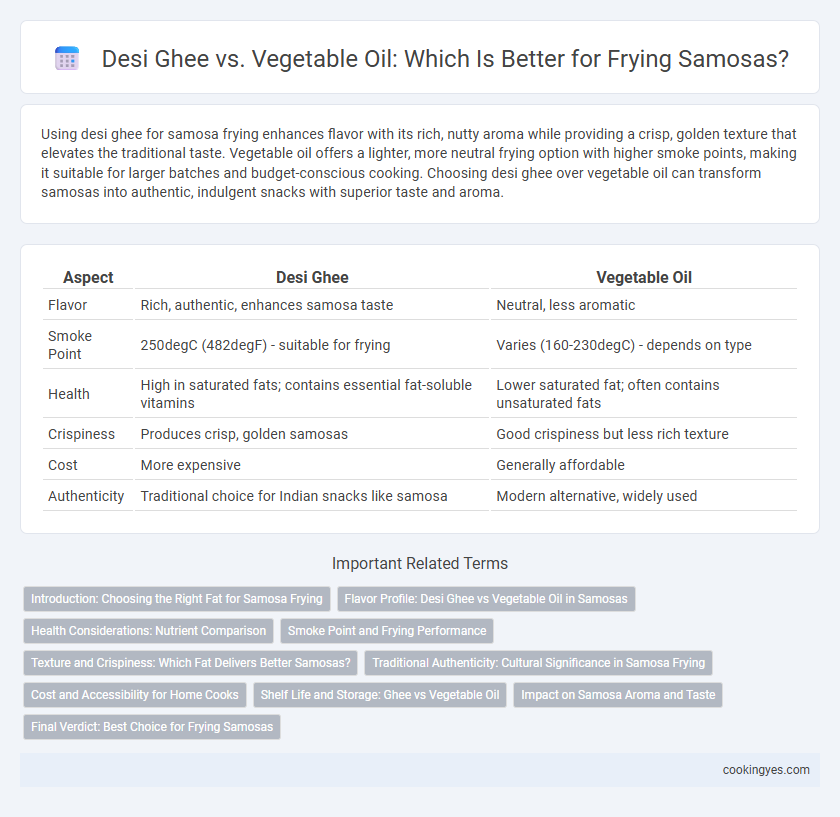Using desi ghee for samosa frying enhances flavor with its rich, nutty aroma while providing a crisp, golden texture that elevates the traditional taste. Vegetable oil offers a lighter, more neutral frying option with higher smoke points, making it suitable for larger batches and budget-conscious cooking. Choosing desi ghee over vegetable oil can transform samosas into authentic, indulgent snacks with superior taste and aroma.
Table of Comparison
| Aspect | Desi Ghee | Vegetable Oil |
|---|---|---|
| Flavor | Rich, authentic, enhances samosa taste | Neutral, less aromatic |
| Smoke Point | 250degC (482degF) - suitable for frying | Varies (160-230degC) - depends on type |
| Health | High in saturated fats; contains essential fat-soluble vitamins | Lower saturated fat; often contains unsaturated fats |
| Crispiness | Produces crisp, golden samosas | Good crispiness but less rich texture |
| Cost | More expensive | Generally affordable |
| Authenticity | Traditional choice for Indian snacks like samosa | Modern alternative, widely used |
Introduction: Choosing the Right Fat for Samosa Frying
Desi ghee and vegetable oil each influence samosa frying differently, affecting flavor, texture, and health aspects. Desi ghee imparts a rich, authentic aroma and crispy texture due to its high smoke point and natural saturated fats. Vegetable oil offers a neutral taste with lower saturated fat content, making it a versatile and often healthier option for frying samosas.
Flavor Profile: Desi Ghee vs Vegetable Oil in Samosas
Desi ghee imparts a rich, nutty flavor and enhances the traditional aroma of samosas, elevating their overall taste profile with a buttery essence. Vegetable oil, while neutral and less aromatic, allows the spiced filling to stand out without adding extra flavor notes. The choice between desi ghee and vegetable oil significantly influences the samosa's texture and mouthfeel, with ghee creating a crispier, more indulgent exterior.
Health Considerations: Nutrient Comparison
Desi ghee contains higher levels of saturated fats and fat-soluble vitamins such as A, D, E, and K, which support overall health and immunity, while vegetable oil provides more polyunsaturated fats and essential omega-6 fatty acids that aid in heart health. Ghee's medium-chain fatty acids are easier to digest and have antimicrobial properties, whereas vegetable oils often contain higher amounts of omega-6 to omega-3 imbalances that may promote inflammation when consumed excessively. Choosing ghee for samosa frying enhances flavor and nutrient absorption but should be balanced with portion control due to its calorie density compared to vegetable oil's lighter profile.
Smoke Point and Frying Performance
Desi ghee has a smoke point around 250degC (482degF), making it highly suitable for deep frying samosas as it provides rich flavor and maintains stability at high temperatures. Vegetable oil typically has a smoke point ranging from 200degC to 230degC (392degF to 446degF), which is adequate but may lead to quicker degradation and off-flavors during extended frying. The higher smoke point and complex fatty acid profile of desi ghee contribute to crispier samosas with an authentic aroma, while vegetable oil offers a neutral taste and lighter texture.
Texture and Crispiness: Which Fat Delivers Better Samosas?
Desi ghee enhances samosa texture by creating a rich, flaky, and crisp outer layer due to its high saturated fat content and low moisture, resulting in superior crispiness. Vegetable oil, with a higher smoke point and neutral flavor, yields lighter, less greasy samosas but often compromises on the deep golden crunch associated with traditional recipes. For authentic, crispy samosas, desi ghee delivers an unmatched texture and mouthfeel compared to vegetable oil.
Traditional Authenticity: Cultural Significance in Samosa Frying
Desi ghee holds immense cultural significance in traditional samosa frying, imparting an authentic aroma and rich flavor that vegetable oil cannot replicate. Using ghee connects the cooking process to ancestral customs, preserving the true essence of authentic samosa recipes passed down through generations. The choice of desi ghee not only enhances taste but also honors the cultural heritage embedded in every crispy, golden samosa.
Cost and Accessibility for Home Cooks
Desi ghee offers rich flavor and authenticity to samosas but comes at a higher cost, making it less accessible for budget-conscious home cooks. Vegetable oil is more affordable and widely available, allowing frequent frying without significant expense. Both options impact texture and taste, but household budget and local availability often dictate the preferred frying medium.
Shelf Life and Storage: Ghee vs Vegetable Oil
Desi ghee offers a longer shelf life compared to vegetable oil due to its low moisture content and natural antioxidant properties, which help prevent rancidity during storage. Vegetable oil, especially when exposed to heat and air, tends to oxidize faster, leading to shorter shelf stability and potential off-flavors in samosas. Proper storage of ghee in airtight containers away from light maintains its quality for months, whereas vegetable oil requires refrigeration or dark storage to extend its usability.
Impact on Samosa Aroma and Taste
Desi ghee enhances samosa aroma with its rich, nutty fragrance, creating a deeper, more authentic flavor profile compared to vegetable oil. The buttery notes from ghee contribute to a crispier texture and a savory taste that vegetable oil often lacks. Vegetable oil imparts a neutral flavor, which may result in samosas tasting less aromatic and less flavorful overall.
Final Verdict: Best Choice for Frying Samosas
Desi ghee offers richer flavor and crispier texture when frying samosas, enhancing the traditional taste and aroma compared to vegetable oil. Vegetable oil, while lighter and more cost-effective, lacks the distinctive buttery notes and may result in less crunchy samosas. For authentic, flavorful samosas with superior crunch, desi ghee is the best choice for frying.
Desi ghee vs Vegetable oil for samosa frying Infographic

 cookingyes.com
cookingyes.com